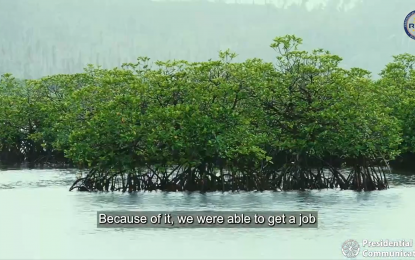
MANGROVES. The Environment department shows a video of mangrove seedlings in Siargao Islands during a presentation on Monday (May 30, 2022). The administration helps local communities through the Enhanced National Greening Program, one of Duterte legacies, with around 387.83 million mangrove seedlings planted from 2007 to 2011 in the island province. (Screengrab)
MANILA – Extreme weather conditions hitting countries in the Asia-Pacific region and the rest of the world are not solely headline-worthy scenarios with oftentimes horrifying death tolls, these also highlight the need for a quick global response that is best mastered in a whole-of-government approach.
Amid these global pressures to reverse climate situations, the Duterte administration has gained ground in ensuring that landmark programs go beyond its six-year term, to achieve sustainable climate resilience.
At the Duterte Legacy Summit 2022 on Monday, the Department of Environment and Natural Resources (DENR) highlighted some of the “life-saving” programs.
These programs were proven to mitigate disastrous climate impacts, not to mention the variety of challenges encountered by the Philippines including volcanic eruptions, coronavirus pandemic, and typhoons.
Lifeline in mangroves
Judilyn Arreza, secretary of a people’s group del Carmen Fisherfolk Association from Siargao Islands, said they are reaping the benefits brought by the flourishing mangrove trees on their island.
The administration, through the DENR, has launched the Enhanced National Greening Program (ENGP), which has secured 387.83 million planted mangrove seedlings in their town from 2017 up to last year.
Arreza said it was only in 2016, through the ENGP, that they have benefitted from such a program since they formed their association in 2011, granting fishers additional income, with tourism also greatly contributing to their financial needs.
“Our community depends on the mangroves, which are very abundant. We have a lot of fish then, and many tourists visit us… We are earning almost PHP3,600 additional income per month, sometimes, during vacation season, we are earning as much as PHP1,000 a day,” she said in Filipino.
However, nature’s wrath did not spare Arreza’s community as Siargao Island became one of the areas devastated by Typhoon Odette.
“Typhoon Odette came, we were really afraid that time because the wind was really strong, we thought we’re gonna die, all of us, almost all the houses have been destroyed, almost all our source of income vanished,” she said.
“Odette” ravaged Visayas and Mindanao in December last year, killing at least 400 people, and affecting over a million others in the region.
Arreza has been grateful to the well-grown mangrove trees they have which somehow provided an impact buffer, just enough to save their lives.
“If it were not for the mangroves, maybe a lot more would have died, or a greater amount of damage would have been made during the typhoon,” she said.
Arezza noted that the DENR has been assisting them to recover through the seedling provision and various training.
Innovative preps
In the same report, DENR Acting Secretary Jim Sampulna cited numerous actions made by the Cabinet Cluster on Climate Change Adaptation, Mitigation, and Disaster Risk Reduction (CCAM-DRR), to “raise the bar” on the country’s environmental approaches.
“LGUs (Local Government Units) were supported with continuous updating of the geohazard maps and in the conduct of risk assessments in their areas to help them plan in disaster and calamities,” he said.
This covers various hazards related to flooding, earthquake, and even volcanic risks, among others.
State-of-the-art technologies for monitoring and forecasting were procured and used across agencies for LGUs.
“Emergency operations centers in 17 regional offices and the National Disaster Risk Reduction Management operation centers were established as command control points for emergency operations and activities,” Sampulna added.
Operation Listo and Disaster Preparedness Manual were some of the tools used to engage the local communities in preparation for earthquakes, typhoons, and other forms of destructive weather conditions.
Over PHP2-billion immediate relief assistance, meanwhile, has been provided to affected families since 2018.
Besides disaster preparations and response, the Duterte administration has also advanced the rehabilitation and preservation of protected areas in the country, such as the Boracay and Manila Bay Rehabilitation.
Sampulna said science-based actions are needed to ensure resilience and sustainability for the country, which the outgoing administration has fostered.
“The Duterte administration shaped the vision and strategy of our country to improve lives, protect the people, and the environment, consistent with the global aspirations for a better, greener, bluer, and healthier post-Covid-19 recovery,” he said. (PNA)
